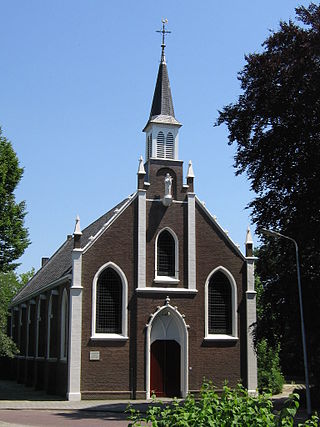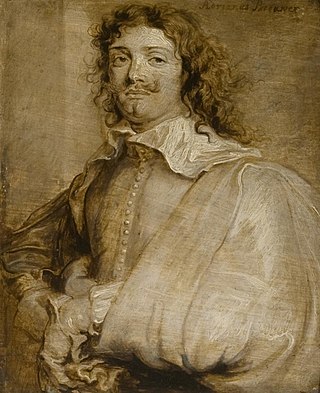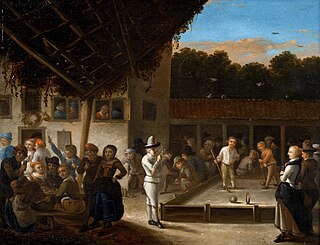
Borsele is a municipality in the southwestern Netherlands on Zuid-Beveland.

Goes is a city and municipality in the southwestern Netherlands on Zuid-Beveland, in the province of Zeeland. The city of Goes has approximately 29,000 residents.

Johan de Witt, Lord of Zuid- en Noord-Linschoten, Snelrewaard, Hekendorp en IJsselvere, was a Dutch statesman and a major political figure in the Dutch Republic in the mid-17th century, the First Stadtholderless Period, when its flourishing sea trade in a period of global colonisation made the republic a leading European trading and seafaring power – now commonly referred to as the Dutch Golden Age. De Witt was elected Grand pensionary of Holland, and together with his uncle Cornelis de Graeff, he controlled the Dutch political system from around 1650 until the Rampjaar of 1672. This progressive cooperation between the two statesmen, and the consequent support of Amsterdam under the rule of De Graeff, was an important political axis that organized the political system within the republic.

Adriaen Brouwer was a Flemish painter active in Flanders and the Dutch Republic in the first half of the 17th century. Brouwer was an important innovator of genre painting through his vivid depictions of peasants, soldiers and other "lower class" individuals engaged in drinking, smoking, card or dice playing, fighting, music making etc. in taverns or rural settings. Brouwer contributed to the development of the genre of tronies, i.e. head or facial studies, which investigate varieties of expression. In his final year he produced a few landscapes of a tragic intensity. Brouwer's work had an important influence on the next generation of Flemish and Dutch genre painters. Although Brouwer produced only a small body of work, Dutch masters Peter Paul Rubens and Rembrandt collected it.

Tuyll is the name of a noble Dutch family, with familial and historical links to England, whose full name is Van Tuyll van Serooskerken. Several knights, members of various courts, literary figures, generals, ambassadors, statesmen and explorers carried the family name.

The Field Elm cultivar Ulmus minor 'Schuurhoek' was originally an old, nameless clone cultivated c.1880 in the vicinity of Goes, Netherlands, which was taken back into cultivation as 'Schuurhoek' by the van't Westeinde nursery at 's-Heer Abtskerke, Zeeland, in the 1950s. It was identified as U. carpinifolia by Fontaine (1968), though treated as a cultivar of U. × hollandica by some authorities.

Cornelis de Graeff, often named Polsbroek or de heer van (lord) Polsbroek during his lifetime was an influential regent and burgomaster (mayor) of Amsterdam, statesman and diplomat of Holland and the Republic of the United Netherlands at the height of the Dutch Golden Age.

Flemish Baroque painting was a style of painting in the Southern Netherlands during Spanish control in the 16th and 17th centuries. The period roughly begins when the Dutch Republic was split from the Habsburg Spain regions to the south with the Spanish recapturing of Antwerp in 1585 and goes until about 1700, when Spanish Habsburg authority ended with the death of King Charles II. Antwerp, home to the prominent artists Peter Paul Rubens, Anthony van Dyck, and Jacob Jordaens, was the artistic nexus, while other notable cities include Brussels and Ghent.

Tobias Verhaecht (1561–1631) was a painter from Antwerp in the Duchy of Brabant who primarily painted landscapes. His style was indebted to the mannerist world landscape developed by artists like Joachim Patinir and Pieter Bruegel the Elder. He was the first teacher of Pieter Paul Rubens.

Gillis van Tilborgh or Gillis van Tilborch (c. 1625 – c. 1678) was a Flemish painter who worked in various genres including portraits, 'low-life' and elegant genre paintings and paintings of picture galleries. He became the keeper of the picture collection of the governor of the Habsburg Netherlands and travelled in England where he painted group portraits.

Hendrik George, Count de Perponcher Sedlnitsky was a Dutch general and diplomat. He commanded the 2nd Netherlands Division at the Battle of Quatre Bras and the Battle of Waterloo.
De Witt is the name of an old Dutch patrician and regenten family. Originally from Dordrecht, the genealogy of the family begins with Jan de Witte, a patrician who lived around 1295. The family have played an important role during the Dutch Golden Age. They were at the centre of Dordrecht and Holland oligarchy from the end of the 16th century until 1672, and belonged to the Dutch States Party.

Gerrit Lundens, was a Dutch painter known for his genre scenes, portraits and a single vanitas painting. He also made copies after prominent masters, including Rembrandt. He further operated an inn and was active as a wine merchant.

Bonifacius de Jonge, Heer of Oosterland and Heer-Jansland in Zeeland was raadpensionaris of Zeeland province in the Dutch Republic between 1615 and 1625.

Jhr. Jacob van den Eynde III also known as Jacques van den Eynde, and better known as Jacobus Eyndius, was a Dutch poet, scientist, historian, and captain. His best known work is the Chronici Zelandiae. His motto was Marte prudens pace clemens.

The Chronici Zelandiae, is a book by Dutch writer Jacob van den Eynde, better known as Jacob Eyndius. The book was published for the first time in 1634, twenty years after the author's death.

Floris I van Haamstede was Lord of Haamstede Castle on Schouwen, and of several other areas in Zeeland, Netherlands.

Ter Hooge Castle is an 18th-century manor in Middelburg. It includes parts of a medieval castle.
Count Wilhelm Heinrich Ludwig Arend von Perponcher-Sedlnitzky was a Dutch-German diplomat.






























